Plastic bottle houses for Sahrawi refugees
Main objectives of the project
Plastic bottle houses transform life for refugees
Tateh Lehbib Barika is no ordinary engineer. He was born in the Sahrawi refugee camps in Algeria, which are home to thousands of people displaced by conflict in Western Sahara more than 40 years ago. Growing up he experienced first-hand the harsh conditions endured in the camps, where metal roofing sheets on mud brick houses intensify the searing desert heat and often blow off during frequent sand storms.
After receiving a scholarship from the UNHCR (the UN’s refugee agency) to study renewable energy, Tateh Lehbib returned to the camps with an innovative idea to improve living conditions for his community, which had been devastated by floods. He set about building a new home for his grandmother using recycled plastic bottles filled with sand. His idea caught the attention of the local UNHCR office, which helped him secure USD$60,000 funding to build 25 more homes.
The community-led project demonstrated how readily and freely available materials could be used to build better homes, reducing refugees’ reliance on external aid and recycling problematic plastic waste. For 50 vulnerable people, the project has provided a safer, cooler place to live and for the community at large, the skills to continue building.
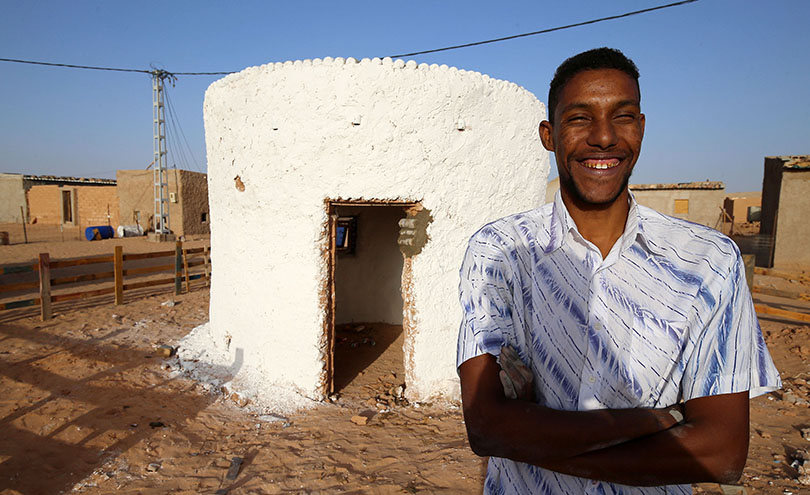
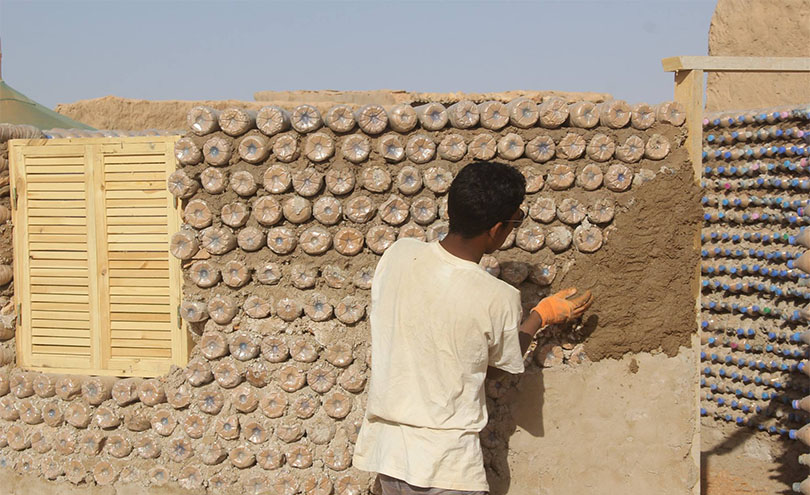
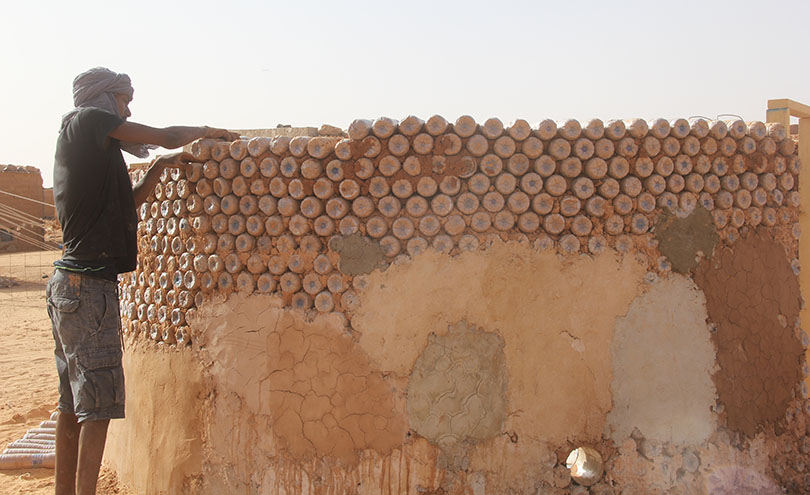

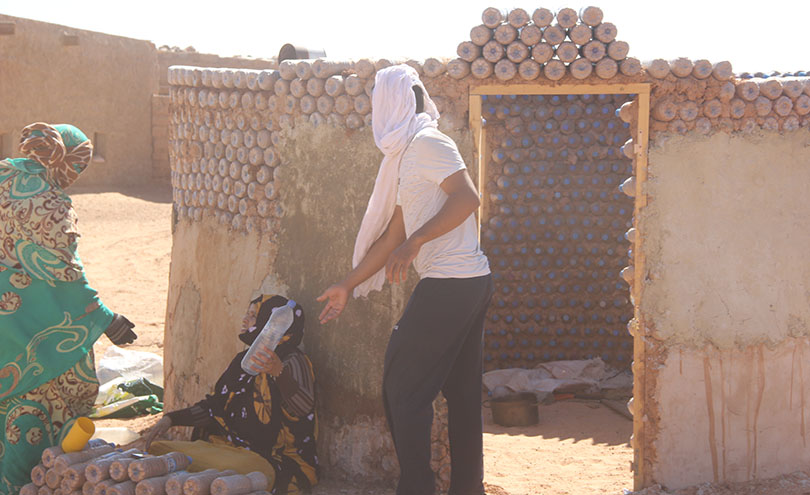

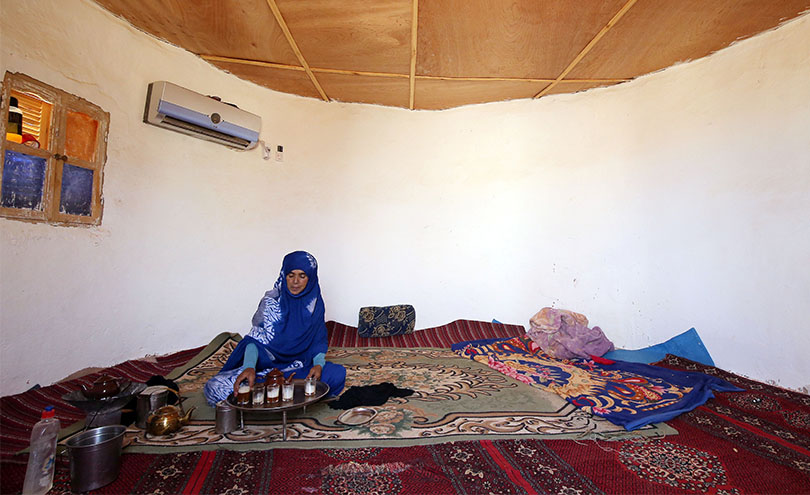
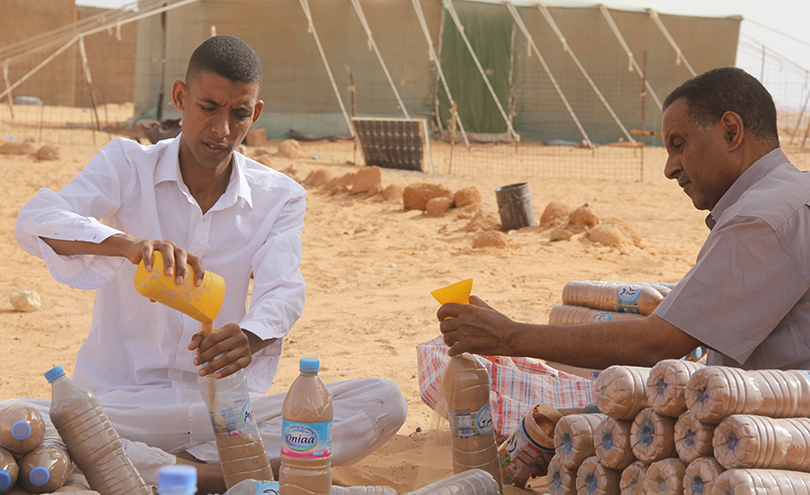

Date
- 2018:
Stakeholders
- Promotor: World Habitat
Location
City: Tinduf
Country/Region: Algeria, Tinduf
Description
Like most settlements of their kind, the Sahrawi refugee camps in Algeria were only ever meant to be a temporary housing solution for people displaced by erupting conflict in Western Sahara in 1975. More than 40 years after they were established, however, the camps are still home to thousands of people, many of whom have never lived anywhere else. Life in the camps is tough. Money and food are scarce and the refugees live in fragile mud houses or tents and endure harsh weather conditions.
Among the typical adobe structures used to house refugee families, are some newer buildings. They stand out because they are round rather than rectangular in shape but it is how they were constructed that is the most remarkable thing about them. The homes were built using recycled plastic bottles filled with sand and form part of an innovative project to improve the living conditions of Sahrawi refugees stuck in ‘temporary’ housing in the camps.
The project is the brainchild of Tateh Lehbib Barika, himself a Sahrawi refugee who was born and raised in the camps. He received a UNHCR (the UN’s refugee agency) scholarship to study renewable energy and returned to build the first prototype plastic bottle home for his grandmother after catastrophic flooding in 2015 destroyed 80 per cent of homes in the camp.
His idea caught the attention of the local UNHCR office in Tindouf, which provided USD$2,000 and helped secure USD$60,000 of funding from the UNHCR to build 25 plastic bottle houses across the five Sahrawi refugee camps in the province. Some refugees were originally sceptical about the initiative, wary it would take away resources from other areas like food assistance but Tateh Lehbib worked hard to raise awareness of the benefits of the project and people gradually came to accept the idea.
The build
Construction began in November 2016 and 27 buildings (two more than expected) were completed by April 2017. The plastic bottle homes have rehoused around 50 refugees who were selected because they are on very low incomes, elderly, or have special needs or disabilities. The homes were built by the refugee community under the direction of Tateh Lehbib. The project directly employed 200 people within the camps, who in turn paid a further 1,500 people to collect and fill bottles.
Each home took about one week to build and required around 6,000 plastic bottles, which were sourced from institutions, schools, hospitals and landfill. Groups of refugees formed to gather and prepare the construction materials. One group was tasked with collecting bottles while another filled them with sand from the dunes. Once filled, a truck transported the bottles to trained masons who stacked them horizontally, filling in the gaps with sand to make a basic cylindrical structure with two windows. The interior walls were covered with a layer of earth and straw, followed by a thin layer of cement. Cement was also used to seal the exterior of the building. The homes have a double layer ceiling to reduce the level of heat coming in – vitally important in an area where temperatures regularly reach 50°C.
Tateh Lehbib’s prototype plastic bottle house cost USD$291 to build. The initial cost of the project was USD$2,400 per home due to increased labour, staffing, transportation, training, materials and tools costs. This reduced to USD$1,630 as the need for training declined. The adobe structures typically used in the camps cost around USD$582 – USD$1,160 to build.
The plastic bottle homes are smaller than their adobe counterparts, but they offer superior protection from fire, sandstorms, floods and high winds. The temperature inside a plastic bottle home is around 5ºC lower than the mud brick alternative and people living in the homes say they feel safer.
Increasing self-sufficiency
A key objective of the project was to improve not only the living conditions within the camps, but also to increase the self-sufficiency of refugees. Used plastic bottles and sand form the bulk of construction materials and can be collected free of charge from institutions, landfill or off the streets. This leaves refugees more able to pay for other materials, like cement, themselves and reduces reliance on external funding.
Even though opportunities within the camps are limited, the Sahrawi people place great value on education, learning and innovation. The project built on this pre-existing culture by running training programmes and workshops for educational centres, women’s associations and youth groups to help inspire and motivate young people to develop their ideas as Tateh Lehbib did. The Sahrawi people’s willingness to learn new skills means the knowledge needed to continue building plastic bottle homes is now embedded in the community. This increased self-sufficiency is crucial in the camps because limited economic opportunities and the harsh climate force refugees to rely heavily on international humanitarian assistance.
The important social impact of the project is coupled with its equally important environmental impact. Plastic waste is a huge and growing problem globally, but even more so in areas where there is little or no formal recycling. Plastic bottle construction recycles tonnes of plastic waste that would likely end up in landfill or in the ocean.
The durability and abundance of used plastic bottles represents a huge environmental challenge – but these qualities also make them good, low-cost building materials for communities with few resources. The plastic bottle method also uses significantly less water than building with mud bricks, preserving a precious commodity in the desert.
The future
Plastic bottle construction is an emerging technique across Latin America and Africa. Following the success of the Sahrawi refugee project, plans are being formed to develop the method further. Tateh Lehbib intends to build a centre in the camp to investigate climatic building design with plastic bottles and hopes to attract engineers and creative architects to help improve design and efficiency, for example by replacing cement with lime and earth and improving ventilation and roof design.
Tateh Lehbib’s aim is to establish plastic bottle construction as common practice and he plans to use the method to build other much-needed resources, such as schools and health centres, in the five Sahrawi camps. He is currently involved in a research project with his professors at the University of Las Palmas de Gran Canaria to develop further solutions.
While the UNHCR-funded project has come to an end, its impact continues to be felt by those living in the homes and also by the community at large. Plastic bottle homes may be basic but they are safe, durable and easily replicable. The self-sufficient nature of the construction method means future homes can be funded by refugees themselves (who have gained skills through participating in the project) or through individual grants. A culture of interdependence and support exists across the Sahrawi community and additional homes are already being built using the plastic bottle method, proving the initiative is sustainable without external funding.
View the full project summary here – available in English only

